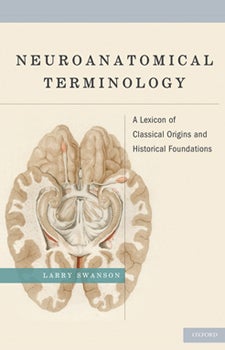A Lexicon of the Brain
In April 2013, University Professor Larry Swanson visited the White House in Washington, D.C., to hear President Barack Obama unveil his Brain Research through Advancing Innovative Neurotechnologies (BRAIN) Initiative. President of the Society for Neuroscience at the time, Swanson was working on a book that supports the research this initiative will undertake.
Published last month, Neuroanatomical Terminology: A Lexicon of Classical Origins and Historical Foundations (Oxford University Press) is an encyclopedic inventory of the human nervous system meant to assist researchers who have the herculean task of mapping the human brain. The book is the product of nearly 15 years of research.
“In terms of a brain map, you need a geography and a list of parts,” explained Swanson, Milo Don and Lucille Appleman Professor of Biological Sciences, and professor of biological sciences, psychology and neurology at USC Dornsife. “Each part of the brain has a different function, so location is everything. And since the brain is a system, you also need to know how these parts are interconnected.”
The BRAIN initiative aims to revolutionize our understanding of the human brain and further investigate treatments for neurological disorders. Billions of dollars in federal funding will be dedicated to brain research over the next 10 years with the goals of accelerating the development and application of innovative technologies, and creating a comprehensive map of the human brain.
Swanson’s book provides a foundation for the creation of this map, which will help researchers better understand how individual brain cells and complex neural circuits interact. Brain mapping and identifying how the different parts are interconnected is fundamental to the development of therapies to treat and prevent disorders like Alzheimer’s, schizophrenia, depression, autism and post-traumatic stress disorder, Swanson said.
“You can think about brain structure in the same way as geography: first you have oceans and countries, then states and an interstate highway system that connects the different areas, then city streets connecting individual people.”

“In terms of a brain map, you need a geography and a list of parts,” said Larry Swanson, whose new book will aid researchers in creating a map of the human brain and its infinitely complicated circuitry.
In a human brain scan, about 500 distinct parts are visible. Once these parts are fully identified, researchers will begin organizing brain map databases for deeper analysis of the connections.
One challenge in the field has been a lack of defined, generally accepted vocabulary for the brain’s components. Swanson’s book addresses this issue.
“The basic problem is that neuroscience does not have a standard vocabulary. In chemistry, for example, there’s a standard way of describing chemical reactions and the elements. But the vocabulary for the nervous system is in a state of confusion — nobody agrees on anything, partly because it’s so complicated. So the hope is that this book will lead to a common vocabulary for describing brain maps.”
A brain map, or detailed “wiring diagram” of the brain, is a visual representation of its neurological circuitry. Since brain structures are made up of individual brain cells, scientists are trying to understand the connections between those millions of cells. Adding another level of complexity, these patterns of connections change with age and the experience of learning new information.
Ultimately, a better understanding of these connections will help unlock the mysteries of the human brain. Swanson’s research lab is currently working on “Google Maps” for the brain to show how you get from one place to another within its circuitry.
His book also examines the brain in historical contexts, from ancient Egypt to the era of Aristotle, from the Middle Ages through the Renaissance. He discusses a papyrus from 1700 BC, written by military surgeons in Egypt, which describes some of the head injuries the surgeons encountered. This papyrus is among the earliest descriptions of the brain and what happens when the brain gets damaged.
Swanson said his book and the standard vocabulary it proposes are just one small part of the giant brain puzzle. But he believes the book is critical.
“Technology is moving so fast and there are so many new ways of looking at things, despite the complexity. Right now is probably the most exciting time ever to be doing research on the brain.”